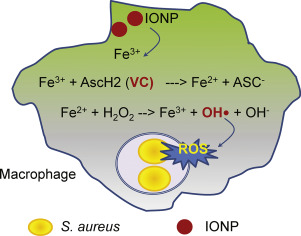当前位置:
X-MOL 学术
›
Nanomed. Nanotech. Biol. Med.
›
论文详情
Our official English website, www.x-mol.net, welcomes your
feedback! (Note: you will need to create a separate account there.)
Harnessing iron-oxide nanoparticles towards the improved bactericidal activity of macrophage against Staphylococcus aureus.
Nanomedicine: Nanotechnology, Biology and Medicine ( IF 4.2 ) Pub Date : 2020-01-23 , DOI: 10.1016/j.nano.2020.102158 Bing Yu 1 , Zhongxia Wang 2 , Layla Almutairi 3 , Songping Huang 2 , Min-Ho Kim 4
Nanomedicine: Nanotechnology, Biology and Medicine ( IF 4.2 ) Pub Date : 2020-01-23 , DOI: 10.1016/j.nano.2020.102158 Bing Yu 1 , Zhongxia Wang 2 , Layla Almutairi 3 , Songping Huang 2 , Min-Ho Kim 4
Affiliation

|
Iron oxide nanoparticles (IONPs) have been increasingly used in various biomedical applications in preclinical and clinical settings. Although the interactions of IONPs with macrophages have been well-reported in the context of nanoparticle toxicity, harnessing the capacity of IONPs in reprograming macrophages towards bactericidal activity has not been explored. Here, using an in vitro culture model of macrophages and an in vivo mouse model of skin wound infection by Staphylococcus aureus (S. aureus), we demonstrated that IONPs in combination with a strategy to trigger the Fenton reaction could significantly enhance bactericidal effects of macrophages against intracellular S. aureus by inducing a M1 macrophage polarization that stimulates the production of reactive oxygen species. Our study supports that harnessing the characteristic of IONPs to tune macrophage polarization to exhibit a bactericidal activity may provide a new strategy for treating infectious diseases.
中文翻译:

利用氧化铁纳米粒子改善巨噬细胞对金黄色葡萄球菌的杀菌活性。
氧化铁纳米颗粒(IONPs)在临床前和临床环境中已越来越多地用于各种生物医学应用中。尽管已在纳米粒子毒性的背景下很好地报道了IONP与巨噬细胞的相互作用,但尚未探索利用IONPs将巨噬细胞重编程为杀菌活性的能力。在这里,使用巨噬细胞的体外培养模型和金黄色葡萄球菌(S. aureus)皮肤伤口感染的体内小鼠模型,我们证明了IONPs与触发Fenton反应的策略相结合可以显着增强巨噬细胞的杀菌作用通过诱导刺激活性氧物质产生的M1巨噬细胞极化来对抗细胞内金黄色葡萄球菌。
更新日期:2020-01-24
中文翻译:

利用氧化铁纳米粒子改善巨噬细胞对金黄色葡萄球菌的杀菌活性。
氧化铁纳米颗粒(IONPs)在临床前和临床环境中已越来越多地用于各种生物医学应用中。尽管已在纳米粒子毒性的背景下很好地报道了IONP与巨噬细胞的相互作用,但尚未探索利用IONPs将巨噬细胞重编程为杀菌活性的能力。在这里,使用巨噬细胞的体外培养模型和金黄色葡萄球菌(S. aureus)皮肤伤口感染的体内小鼠模型,我们证明了IONPs与触发Fenton反应的策略相结合可以显着增强巨噬细胞的杀菌作用通过诱导刺激活性氧物质产生的M1巨噬细胞极化来对抗细胞内金黄色葡萄球菌。











































 京公网安备 11010802027423号
京公网安备 11010802027423号